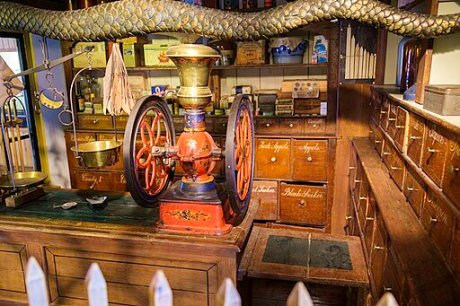Whether a seaman’s figurehead or a rare sextant, marine antiques are more than just decoration. They symbolize a rich history of international seafaring.
But, like any other collectible, value can fluctuate. The key to successful collecting is understanding the factors that affect value. Here are some tips to get you started.

Table of Contents
Origins
The sea is a mysterious and enchanting place for many people, inspiring awe and wonder as well as a sense of adventure. Maritime antiques can capture this feeling and bring it into the home for all to enjoy. They can be used as an interior design feature to create a unique nautical theme or even just to add a touch of nautical elegance.
Marine and nautical items can be found in antique shops, auction houses, flea markets, and private collections all over the world. These items can include everything from nautical works of art to antique mariners tools. The most common maritime antiques are paintings of seafaring scenes or ship models. Many famous artists, including Monet, Rembrandt, and Van Gogh, have painted maritime scenes that are still widely sought after. Other popular marine antiques are brass compensating binnacles, boat clocks, and authentic ship ladders.
Unlike some other types of antiques that can be damaged by time and use, marine and nautical items often hold up quite well to age. This is due to their durability and the materials used. However, as with other types of antiques, condition plays an important role in value. Items that are close to new or mint conditions will have the highest value, while items with significant damage will see a reduction in value.
While it can be a fun and rewarding hobby to collect maritime antiques, a few things should be considered before beginning. For one, it is crucial to consider the space available for storing and displaying these pieces. Also, it is a good idea to seek the opinion of a professional appraiser prior to making any major purchases. An expert will be able to provide an accurate estimate of value based on their years of training and experience.
With these tips in mind, anyone can confidently begin collecting maritime and nautical antiques. This genre of the antique market is growing in popularity, so be sure to take advantage of it. With the right care and attention, a collector can build a first-class collection over time.
Styles
Whether a collector is seeking the perfect decorative accent for a beach house or an anchor-shaped door knocker, a decorative piece that recalls a sea voyage, a piece of scrimshaw, or an authentic antique ship’s wheel, there are many options. These items are offered at a wide range of prices and provide fascinating insights into the lives of seamen in past generations. Marine antiques cover a broad spectrum of art and ephemera, including figureheads and stern boards, ships’ furnishings, nautical instruments and aids, navigation tools such as antique sextants and octants, maritime prints, shipwreck ephemera and relics, and whaling tools and harpoons.
The book’s encyclopedic coverage includes an overview of the history of maritime collecting, an explanation of the various styles of marine antiques, and an in-depth discussion of the craftsmanship involved in producing these pieces. It also offers a number of practical suggestions for the collector, such as how to evaluate a piece and how to protect and store it.
In addition to providing a comprehensive introduction to the world of marine antiques, the book also illustrates hundreds of them through detailed photographs. It includes everything from a simple carved mahogany ship’s figurehead to an elaborate octagonal brass comping binnacle salvaged from a working merchant ship. A large selection of antique clocks and other timepieces are also shown, as well as an assortment of 19th-century furniture designs ranging from a camphorwood lap desk to a whalebone chest with three painted panels of naively drawn sailing scenes.
Besides providing enjoyment and education for collectors, marine antiques perform a valuable function in preserving our cultural heritage. While museums cannot collect and care for every item that tells a story of our nation’s seafaring history, private collections bring a little of the sea into people’s homes. This book aims to encourage new and experienced collectors to continue the tradition of preserving and caring for these objects for future generations.
Craftsmanship
The heirloom quality of many maritime antiques is the result of superior craftsmanship. This is not only about the technical skills of the maker but also his or her sense of beauty and utility. Authentic nautical antiques add serene aesthetics to any home while capturing the deep sea’s excitement and adventure. They represent the thrill of a voyage and the promise of new discoveries.
Besides the enjoyment and awareness collectors gain from their collections, they also serve a valuable function by preserving maritime history and artifacts that museums cannot collect and care for. Moreover, collectors can acquire a first-class collection over time – even the newest entrant to the field can have a very satisfying experience as he or she accumulates items of quality and distinction.
As a generalization, nautical collectors tend to be frugal and will only pay top dollar for known provenance items associated with a particular ship or event. However, this can sometimes work against a marine collector, particularly when an item goes out of favor for some reason. For example, chronometers are currently out of vogue and can command only very low prices. On the other hand, a sextant or octant can still bring high prices as it is an essential navigational tool and historically significant.
Long ocean voyages left plenty of time for bored sailors to develop crafts and arts. Scrimshaw – the painstaking etching of detailed scenes on whales’ teeth or ivory tusks – is one example that continues to mesmerize maritime collectors. Other examples include intricate shell work, wool depictions of ships or travels, and miniature figurehead carvings.
This category also has a wide range of decorative objects and furniture from the sea, including nautical clocks shaped as ships’ wheels, anchors, and mahogany capstan-shaped inkwells. In addition, there are model boats and nautical miscellany. Finding these objects can be daunting for the novice collector, but a reputable and knowledgeable dealer can guide him or her in a rewarding journey of collecting. For example, Annapolis Maritime Antiques offers a vast selection of maritime antiques and nautical artifacts from around the world and across the seven seas. Their commitment to authenticity and quality has led them to expand their offerings beyond maritime artwork to sophisticated wall units; furniture, floor, and woodwork restorations; kitchen renovations; and even military contracting.
Value
Marine antiques are items related to the lives of seamen in past generations – from scrimshawed items, sailor-made ship models, and navigational aids to whaling implements, furnishings, and accessories. They are objects that tell a story, often of an extraordinary event, and they are valuable for their history and aesthetic value. This volume illustrates hundreds of such treasures and includes a useful price guide.
The art of collecting marine antiques is a time-consuming and sometimes frustrating endeavor, as prices can fluctuate greatly depending on the demand for an object at any given time. As a generalization, collectors are frugal and will only pay top dollar for items that have a known provenance – associated with a famous person, a specific ship, or an event – or are particularly rare. Hence, many marine paintings by Monet and Rembrandt rarely change hands, while fine pieces of maritime hardware and whaling ephemera command high prices.
In the current sluggish economy, high-quality nautical antiques aren’t as plentiful as they used to be. This is especially true in the high end, where there has been a marked decrease in interest. Added to this is that television shows about pickers and pawn shops have created unrealistic expectations in values among accumulators and collectors. This creates a situation where many fine nautical items sell for much less than their true worth.
However, there are still plenty of good opportunities for the discerning collector. The best places to shop for these items are reputable dealers with years of experience in the field. These specialists will be able to provide expert advice and will have access to a vast network of clients. They will also be able to offer items that you might not have been able to find in a regular auction or a traditional retail outlet.
Founded in 1989, Annapolis Maritime Antiques (AMA) has grown from a whimsical start to a highly professional enterprise. Its staff has a combined 80 years of woodworking and decorative arts experience. Their projects range from sophisticated wall units to furniture, floors, and woodwork restorations. They can even help with major naval renovations – they have worked on the Navy Academy library and chapel.




